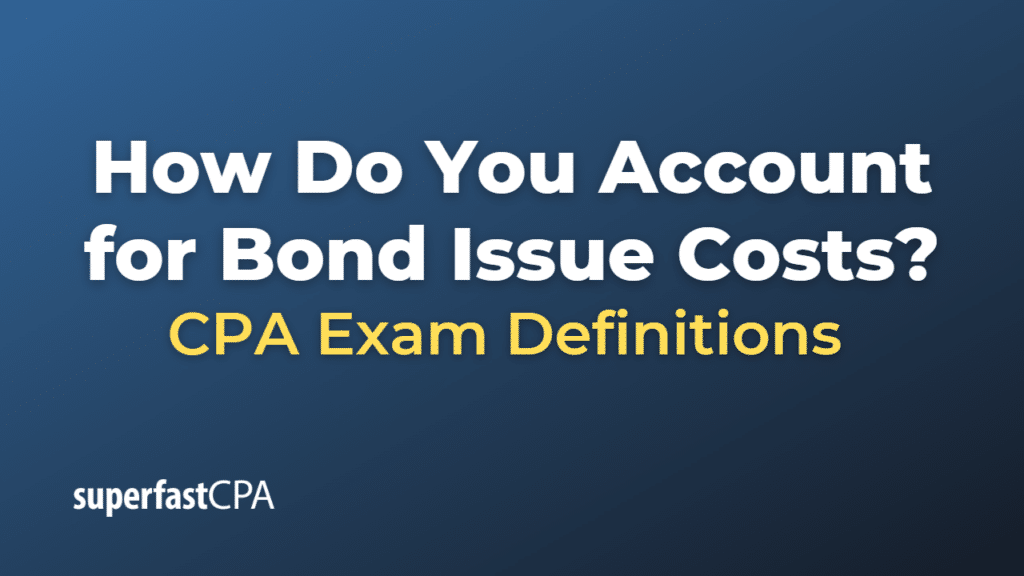How Do You Account for Bond Issue Costs
Bond issuance costs are the costs that a company incurs when issuing new bonds, including legal fees, accounting fees, underwriting costs, and other related expenses. These costs cannot be expensed immediately but must instead be amortized over the life of the bond.
According to the Generally Accepted Accounting Principles (GAAP), bond issuance costs are treated as a direct reduction from the carrying amount of the bond liability. This treatment is similar to how a discount on bond payable is treated.
Here’s an example of how you would account for bond issue costs:
- At the time of the bond issuance: Record the bond issuance costs as a deferred charge on the balance sheet. Assume the company issued bonds for $1,000,000 and had $20,000 in bond issuance costs.Debit: Cash $980,000 (=$1,000,000 – $20,000) Debit: Bond Issue Costs $20,000 Credit: Bonds Payable $1,000,000
- Over the life of the bond: Amortize the bond issuance costs over the life of the bond using the straight-line method or effective interest method. If the bond has a 10-year life, annual amortization would be $2,000 (= $20,000 ÷ 10) using the straight-line method.Debit: Amortization Expense $2,000 Credit: Bond Issue Costs $2,000
The amortization expense will be reported on the income statement, while the bond issue costs (net of accumulated amortization) will be reported as a direct reduction from the carrying amount of the bond liability on the balance sheet.
Remember that the above accounting treatment reflects the practices commonly followed in the U.S. as per U.S. GAAP. International Financial Reporting Standards (IFRS) may treat bond issuance costs differently. IFRS treats bond issuance costs as an asset and amortizes it to profit or loss over the term of the bond. Always consult with a qualified accountant or auditor to ensure compliance with the most recent and relevant accounting standards.
Example of How to Account for Bond Issue Costs
Let’s say a company, XYZ Inc., decides to issue bonds to raise $500,000 for business expansion. The bonds have a 5-year term, and the bond issuance costs (legal fees, underwriting costs, etc.) are $10,000.
Here’s how the company would account for these costs:
1. At the time of bond issuance:
The company would record the cash received and the bond payable at the face value of the bond, and the bond issuance costs as a deferred charge. The journal entries would look like this:
Debit: Cash $490,000 (=$500,000 – $10,000)
Debit: Bond Issue Costs $10,000
Credit: Bonds Payable $500,000
This records the cash received (net of issuance costs), the cost of issuing the bonds, and the face value of the bonds payable.
2. Over the life of the bond:
The bond issuance costs would be amortized over the life of the bond. If we use straight-line amortization, the costs are spread evenly over the term of the bond. So, in this case, the annual amortization would be $2,000 (= $10,000 ÷ 5 years).
Each year, the company would record the following journal entry:
Debit: Amortization Expense $2,000
Credit: Bond Issue Costs $2,000
This reduces the deferred charge (Bond Issue Costs) and records the annual expense.
After one year, the balance sheet would report Bond Issue Costs of $8,000 as a direct deduction from Bonds Payable in the liability section, and the income statement would report Amortization Expense of $2,000.
Remember, this is under U.S. GAAP. If the company followed IFRS, the bond issue costs would be treated as an asset and amortized to profit or loss over the term of the bond. Always consult with a certified accountant or auditor to ensure the accounting treatment meets the most recent and relevant accounting standards.













